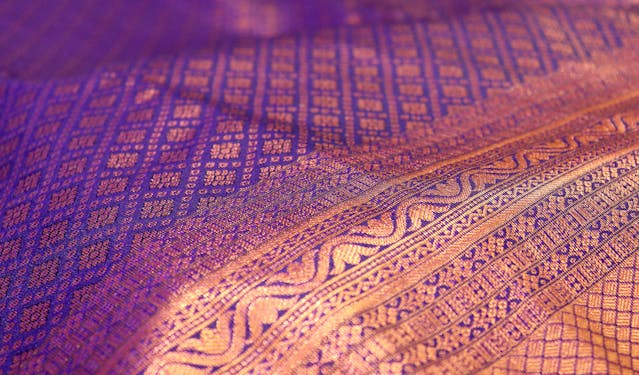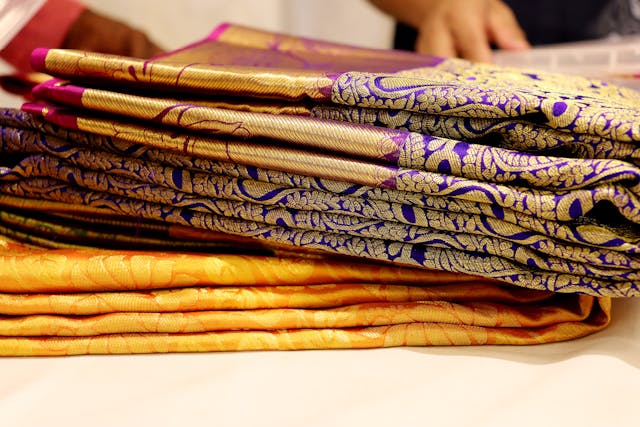If you’ve ever attended a South Indian wedding or festival, you’ve likely seen the bride draped in a radiant Kanchipuram Silk Saree. Originating from the temple town of Kanchipuram in Tamil Nadu, these sarees are more than just garments; they’re woven stories of tradition, culture, and artistry. Kanchipuram silk sarees are also commonly known as Kanjivaram silk sarees. Additionally, they are sometimes referred to as Kanchipuram pattu sarees, with “pattu” being the Tamil word for silk. Kanchipuram on Maps.
🧵 What are Kanchipuram Silk Sarees?
Handwoven with pure mulberry silk and adorned with intricate zari work, Kanchipuram Silk Sarees are renowned for their durability and lustrous finish. The designs often draw inspiration from temple architecture, nature, and mythology, making each saree a unique masterpiece.
Historical Legacy
The tradition of weaving Kanchipuram sarees dates back over 400 years, with artisans employing age-old techniques passed down through generations. The town’s proximity to the silk-producing regions and its association with temples have significantly influenced the saree’s design and significance.
🌟 Why are Kanchipuram Silk Sarees Famous?
- Cultural Significance: These sarees are considered auspicious and are often worn during weddings, religious ceremonies, and festivals.
- Artisanal Craftsmanship: The weaving process involves skilled artisans who employ traditional techniques passed down through generations.
- Distinctive Designs: Motifs such as temple borders, peacocks, and elephants distinguish Kanchipuram sarees from other silk sarees.

🧶 How are Kanchipuram Silk Sarees Made?
Creating a Kanchipuram Silk Saree is a meticulous process:
- Yarn Preparation: Silk threads are dyed using natural colors.
- Designing: Artisans sketch traditional motifs onto the silk fabric.
- Weaving: Using a handloom, the silk threads are woven with gold and silver zari to form intricate patterns.
- Finishing: The saree undergoes washing and ironing to enhance its sheen and finish.
This labor-intensive process ensures each saree is a unique piece of art.
Weaving Techniques
A hallmark of Kanchipuram sarees is the ‘Korvai’ technique, where the pallu and body are woven separately and then joined, creating a distinctive zigzag pattern. This method ensures durability and a seamless transition between the saree’s parts.
Zari Work
The zari work on Kanchipuram sarees is typically made from pure gold or silver threads. Authentic zari can be identified by gently scratching it; a reddish hue indicates purity, whereas imitation zari appears white.

🛍️ Where to Buy Kanchipuram Silk Sarees?
You can purchase authentic Kanchipuram Silk Sarees from:
- Local Weavers in Kanchipuram: Visit the town to experience a wide range of authentic sarees.
- Reputed Retailers: Stores like House of Hind and Panjavarnam offer a curated collection of Kanchipuram sarees online.
- Online Marketplaces: Platforms such as Kankatala provide a variety of sarees with detailed descriptions and pricing.
Authenticity Indicators
To ensure the authenticity of a Kanchipuram saree:
- Silk Mark Certification: Look for the ‘Silk Mark’ label, certifying the saree’s purity.
- Ring Test: Pass the saree through a ring; if it slides through effortlessly, it’s likely genuine.
- Burn Test: Burn a small thread; real silk emits a distinctive odor similar to burning hair.
💰 Pricing
The price of a Kanchipuram Silk Saree varies based on factors like quality of silk, zari work, and design intricacy:
- Budget Range: ₹5,000 – ₹15,000 for semi-silk sarees with basic designs.
- Mid-Range: ₹15,000 – ₹50,000 for sarees with moderate zari work and traditional motifs.
- Premium Range: ₹50,000 and above for sarees with intricate gold and silver zari work, often chosen for weddings.
✨ Conclusion
Kanchipuram Silk Sarees are not just garments; they are a reflection of South India’s rich cultural tapestry. Owning one is akin to possessing a piece of history and artistry. Whether you’re attending a wedding or a festival, draping yourself in a Kanchipuram saree will undoubtedly make you the center of attention.
Checkout our other blogs on Famous Items category.





4 thoughts on “Kanchipuram Silk Sarees: Everything You Need to Know About This Timeless Indian Attire”
Pastel Kanjeevaram silk sarees are a dreamy blend of tradition and modern elegance. So soft, subtle, and perfect for a graceful bridal look!
Very True @Vinod. Check out our other blogs too in this https://webfuse.in/tag/famous-indian-crafts/ series.
Kanjeevaram wedding sarees are a bride’s perfect blend of tradition and elegance
You are right @Vinod. Check out our other blogs too in this https://webfuse.in/tag/famous-indian-crafts/ series.